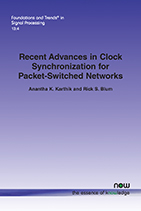Recent Advances in Clock Synchronization for Packet-Switched Networks
By Anantha K. Karthik, Qualcomm Technologies Inc., USA, anankart@qti.qualcomm.com | Rick S. Blum, Lehigh University, USA, rblum@lehigh.edu
Abstract
Clock synchronization is a mechanism for providing a standard time to various devices across a network. This monograph provides a comprehensive overview of recent developments for clock synchronization protocols built on two-way message exchanges. Several clock synchronization protocols are available in the literature for distributing time from high-cost, high-stability clocks (termed masters) to low-cost, low-stability clocks (termed slaves) via an interconnecting network. A number of clock synchronization protocols are built on two-way message exchanges. These include the timing protocol for sensor networks (TPSN), lightweight time synchronization (LTS) protocol, tiny-sync and mini-sync, network time protocol (NTP) and the IEEE 1588 precision time protocol (PTP). The messages traveling between the master and slave nodes can encounter several intermediate switches and routers, accumulating delays at each node. The main factors contributing to the overall delay are the fixed propagation and processing delays at the intermediate nodes along the network path between the master and slave, as well as the stochastic queuing delays at each such node. Popular probability density function (pdf) models for modeling the stochastic delays include Gaussian, exponential, gamma, Weibull, and log-normal. Although these pdf models for the stochastic queuing delays apply to several scenarios, they might not be suitable in specific scenarios such as cellular base station synchronization using mobile backhaul networks and IEEE 1588 in 4G Long Term Evolution (LTE) networks. Further, there could be possibly unknown asymmetries between the fixed path delays in the forward master-to-slave path and the reverse slave-to-master path. These unknown asymmetries could arise from various sources, including delay attacks or incorrect modeling. In this monograph, we present recent developments for clock synchronization protocols built on the two-way message exchange. After an introduction to the basic concepts and mathematical models, the optimum estimators are presented for estimating the clock skew and offset that are applicable for any pdf model of the stochastic delays. Robust algorithms that can also handle unknown path asymmetries are presented next. The focus is on techniques that consider practical, relevant measurement models in order to guide the reader from physical observations to the actual synchronization of the clocks at the slave and master.
Recent Advances in Clock Synchronization for Packet-Switched Networks
Clock synchronization is a mechanism for providing a standard reference time to various devices across a distributed network. It is critical in modern computer networks because every aspect of managing, securing, planning, and debugging a network involves determining when particular events happen. Global Positioning Systems (GPS) are a popular mechanism for achieving synchronization, but these are not always practical in network systems.
This monograph concentrates on a technique called Network Time Distribution which is often more cost-effective than GPS-based timing, as it does not require any dedicated hardware and can often make use of the existing network resources for synchronizing devices across the network. The technique uses a master/slave construction to synchronize the time throughout devices on a network. To do this, two-way message exchange is required which can be subject to network delays. The authors present recent developments to combat the degrading effects of stochastic delays for clock synchronization protocols based on two-way message exchange. While the techniques presented in the monograph apply to many applications and any clock synchronization protocol based on two-way message exchanges, the authors mainly discuss the applications in the context of IEEE 1588 PTP standard applied to telecommunication networks.
Recent Advances in Clock Synchronization for Packet-Switched Networks is of interest to telecommunication engineers designing and building a broad range of telecommunication systems. It provides an introduction to the theory as well as practical results for implementation in real-world systems.
